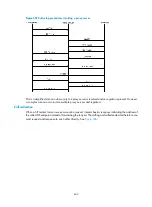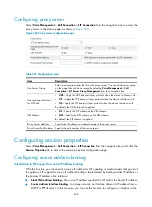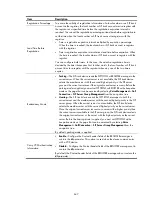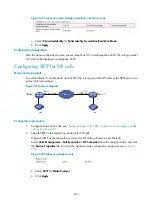
641
Table 244
Configuration items
Item Description
SIP Listening Transport
Layer Protocol
•
UDP
—Specify UDP as the transport layer protocol for incoming SIP calls and
enables UDP listening port 5060.
•
TCP
—Specify TCP as the transport layer protocol for incoming SIP calls and
enables TCP listening port 5060.
•
TLS
—Specify TLS as the transport layer protocol for incoming SIP calls and
enables TLS listening port 5061. If you select this option, you must select a
certificate from the
Certificate
list.
By default, both the UDP and TCP listening ports are enabled, and the TLS listening
port is disabled.
Configure this item in either of the following scenarios:
•
If the device is the call receiver, you must enable the listening port of the
transport layer protocol used by the incoming calls.
•
If TCP or TLS is selected as the transport layer protocol when the device initiates
a call, you must specify it as the SIP listening transport layer protocol in this item.
Otherwise, no register request can be initiated.
Resetting the setting for this item deletes the established connections.
Configuring media security
Select
Voice Management
>
Call Connection
>
SIP Connection
from the navigation tree, and click the
Session Properties
tab to access the page as shown in
Figure 663
Configuring media security
Table 245
Configuration item
Item Description
Media Protocol
•
RTP
—Specify the Real-time Transport Protocol (RTP) as the media flow protocol
for SIP calls.
•
SRTP
—Specify the Secure Real-time Transport Protocol (SRTP) as the media flow
protocol for SIP calls.
By default, the RTP protocol is applied.
When both the RTP and SRTP protocols are specified as the media flow protocols
for SIP calls:
•
If the device is the call initiator, both two media flow protocols are carried in the
INVITE message for the receiver to select.
•
If the device is the call receiver, the SRTP protocol is first used for media flow
negotiation. If the negotiation fails, the RTP protocol is used.
Summary of Contents for MSR SERIES
Page 17: ...xv Documents 835 Websites 835 Conventions 836 Index 838 ...
Page 20: ...3 Figure 3 Initial page of the Web interface ...
Page 42: ...25 Figure 13 Firefox Web browser setting ...
Page 59: ...42 Figure 27 Checking the basic service configuration ...
Page 73: ...56 Figure 35 Sample interface statistics ...
Page 156: ...139 Figure 139 Rebooting the 3G modem ...
Page 168: ...151 Figure 152 Configuring Web server 2 ...
Page 174: ...157 Figure 158 Configure the URL filtering function ...
Page 242: ...225 Figure 233 Enabling the DHCP client on interface Ethernet 0 1 ...
Page 247: ...230 Figure 236 The page for configuring an advanced IPv4 ACL ...
Page 255: ...238 Figure 241 Advanced limit setting ...
Page 298: ...281 e Click Apply 2 Configure Router B in the same way Router A is configured ...
Page 400: ...383 Figure 387 Verifying the configuration ...
Page 405: ...388 ...
Page 523: ...506 Figure 530 Ping configuration page ...
Page 775: ...758 Figure 785 Configuring a jump node ...
















































